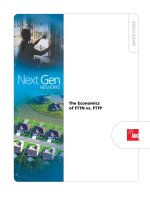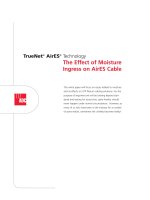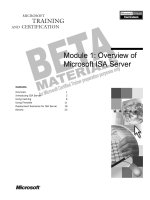Tài liệu The New Generation of Microsoft Certifications: What’s at the Core? pdf
Bạn đang xem bản rút gọn của tài liệu. Xem và tải ngay bản đầy đủ của tài liệu tại đây (349.63 KB, 7 trang )
The New Generation
of Microsoft
Certifications:
What’s at the Core?
1-800-COURSES
www.globalknowledge.com
Expert Reference Series of White Papers
Introduction
Microsoft has once again come up with a new suite of certifications. So, what are these all about and why is
there a new generation of credentials?
One of the problems today is that there are an abundance of credentials in the IT world, making it increasingly
difficult for managers to understand which certification best meets the needs of their department and organi-
zation.
For individuals
, the question becomes: what added value does a specific certification provide, and, ulti-
mately, how can I distinguish myself from other IT professionals?
Customers told Microsoft that they wanted a program that is
focused and flexible, challenging and
credible, and relevant and simple.
So, Microsoft went back to the drawing board and created the latest generation of certifications based on
industry and customer feedback with the goal of making them more targeted, relevant to the latest technolo-
gies, and geared towards specific job roles. The new credentials highlight the primary technology skill set and
job role of each individual and focus on core technical and professional skills.
The new certification framework gives IT managers another tool to distinguish candidates who must meet spe-
cific job criteria. The program also gives individuals the ability to highlight specialization (
i.e., Microsoft
Certified Technology Specialist for SQL Server 2005
[MCTS: SQL Server 2005]).
What’s It All About?
Focused and Flexible
One of the positive changes to the new program is building certifications to reflect specific and well-under-
stood job roles within organizations
.
T
he new model reflects a three-tiered system with the entry-level
T
echnology Specialist (MCTS), the mid-level IT Professional (MCITP)/Professional Developer (MCPD), and the
Architect Series (MCA) at the top. The three tiers coupled with specific technology choices (SQL, Visual Studio,
etc.) to form an a la carte certification model.
This targeted certification model enables individuals to identify their various skill sets and provides for a more
flexible certification path to meet specific job-related needs
.
Challenging and Credible
What is the v
alue of certification and why should I get certified? These are big questions for individuals as well
as organizations. Easier tests lessen the value of the credential. One of the positive changes implemented by
Mike Manning, Global Knowledge Instructor, MCSA, MCP
The New Generation of Microsoft
Certifications: What’s at the Core?
Copyright ©2007 Global Knowledge T
raining LLC. All rights reserved.
Page 2
M
icrosoft was to make the testing process more rigorous and challenging. In 2005, Microsoft introduced per-
formance-based testing using simulation technology with several of the Windows Server 2003 core exams.
Microsoft is looking at using more and more of this simulation-style testing to make the exams more challeng-
ing, with the goal of mimicking real-world scenarios in the test booth. There does seem to be buy-in from
Redmond for raising the bar in the testing process with the ultimate goal of increasing the value of certifica-
tion for individuals and organizations.
Relevant and Simple
The new certification structure is designed to be more relevant, simple, and easy to understand. With this in
mind, Microsoft reduced the number of exams expected to complete a certification. For the current tracks, the
MCTS requires one to two exams. One level up from the MCTS, the MCITP and MCPD credentials require the
relevant MCTS as a pre-requisite, and then passing an additional exam or two. The exception is the MCPD
Enterprise Application Developer, which requires all three available Visual Studio MCTS credentials as a pre-
requisite. The certifications path has been streamlined with the goals of making the credentials simpler and
more relevant for both individuals and IT managers.
A Closer Look at the Certifications
Microsoft has been offering certification programs now for 14 years and has been due to revamp the program.
Microsoft’s new certification model consists of three series (technology, professional, and architect) and four
credentials (MCST, MCITP
, MCPD, and MCA).
This newest generation of Microsoft certifications provides a more
targeted framework for IT managers to qualify and validate core technical, professional, and architectural
skills. It also provides IT professionals with a more flexible, relevant, and simpler way to showcase their skill
sets
. The following graphic illustrates the makeup of the new Certification model.
Copyright ©2007 Global Knowledge T
raining LLC. All rights reserved.
Page 3
The Technology Series (MCST)
The Technology Series of certifications are the starting point in a three-tiered model. This series are technology-
focused and include job-role skills. These typically consist of one or two exams. IT professionals have the ability
to target specific technologies and demonstrate in-depth knowledge and expertise in a broad range of special-
ized technologies. The Technology Series includes seven Certified Technology Specialist certifications including:
• Technology Specialist: .NET Framework 2.0 Web Applications
• Technology Specialist: .NET Framework 2.0 Windows Applications
• Technology Specialist: .NET Framework 2.0 Distributed Applications
• Technology Specialist: SQL Server 2005
• Technology Specialist: BizTalk Server 2006
• Technology Specialist: Microsoft Office Live Communications Server 2005
• Technology Specialist: Microsoft Windows Mobile 5.0 Applications
The Professional Series (MCITP/MCPD)
The Professional Series credentials are the next tier up from the Technology Series and reflect specific job roles
within organizations. This series of credentials builds on the
Technology Series and the relevant Technology
Series certifications act as pre-requisites for this middle tier of certifications. There are typically one to three
exams required to achieve this level of certifications. The credentials are focused on job roles and skill-sets,
including design, project management,
operations management, and planning. Microsoft currently offers two
Professional series credentials, the Microsoft Certified IT Professional (MCITP) and the Microsoft Certified
Professional Developer (MCPD).
Microsoft Certified IT Professional (MCITP)
The Microsoft Certified IT Professional certification highlights specific areas of expertise and job role.
This credential demonstrate skill sets in planning, deploying, supporting, maintaining, and optimizing IT infra-
structures, and distinguishes you as an expert in database administration, database development, or business
intelligence
.
• IT Professional: Database Developer
• IT Professional: Database Administrator
• Professional:
Business Intelligence Developer
Microsoft Certified Professional Developer (MCPD)
This certification was created for developers working with .NET Framework 2.0 applications using Microsoft
Visual Studio 2005, and it provides a simpler, more targeted framework to showcase your technical skills for
specific developer job roles
.
T
he Microsoft Certified Professional Developer credentials differentiate you as an expert
Windows
Application
Developer, Web Application Developer, or Enterprise Applications Developer. This certification highlights your
ability to build rich applications with a variety of platforms using the .NET Framework 2.0. There are three
MCPD certification paths, including:
• Professional Developer: Web Developer
• Professional Developer: Windows Developer
• Professional Developer:
Enterprise
Applications Developer
Copyright ©2007 Global Knowledge T
raining LLC. All rights reserved.
Page 4
The Architect Series (MCA)
One of the more exciting developments late last year was the announcement by Microsoft of the creation of a
senior-level IT Architect certification program. This credential sits atop the three tiers and was built around
identifying and validating top industry experts in IT architecture. Qualifications and requirements for this cre-
dential include:
• Ten years minimum advanced IT industry experience
• Three+ years of experience as a practicing architect
• Possess strong technical and managerial skills
• Work closely with a mentor in the industry
• Appear before an Oral Board of industry peers
One of the unique elements of this credential is that it was built on feedback directly from the architect com-
munity. This type of certification program fills a gap in the industry by taking certification to a new level. Until
recently, the majority of the certification programs have relied on computer-based exams to test mainly techni-
cal knowledge. This new architectural certification will require candidates to have a combination of broad
range of skills
, significant work history in the field, and ability to demonstrate a high level of architectural
expertise in past projects. This certification takes a stark departure from traditional Microsoft certifications. It is
broad-based and inclusive of non-proprietary technologies.
The program targets practicing solutions and infrastructure architects who have successfully designed,
archi-
tected,
and implemented solutions through the entire IT life cycle. This program has set the bar high and iden-
tifies top industry experts in IT architecture. These architects are experienced in using diverse platforms and
technologies to solve business problems and provide business metrics and measurements. Candidates are
required to interview and present to a review board of their peers on the success of past projects.
There are currently two vendor-neutral Microsoft Architectural certifications that validate broad architecture
skills. These certifications are:
• Microsoft Certified Architect: Infrastructure
• Microsoft Certified Architect: Solutions
In addition, there is also one product-specific architectural certification, the Messaging Architect Program. This
is the first product-specific architect program under the Microsoft Certified Architect umbrella. The goal for this
certification is to provide the top-tier training and certification on Microsoft Exchange Server revolving around
messaging to address the most complex customer requirements.
• Microsoft Certified
Architect: Messaging
Top 10 Benefits of Certifications
Microsoft-certified IT professionals give individuals and organizations a competitive adv
antage
.
According to a
Burlington study in 2003, companies with that place a priority on certified staff enjoy a 15% increase in proj-
ects deployed on-time and on-budget, a 17% decrease in spending on external consultants, an 18% decrease
in downtime, and a 14% increase in end-user satisfaction.
F
rom an organizational perspective
,
the top 10 reasons benefits to achieving and promoting certification
include:
Copyright ©2007 Global Knowledge T
raining LLC. All rights reserved.
Page 5
1. Gain a Competitive advantage: Individuals and employees who hold Microsoft certifications bring
advanced skill-sets to provide greater levels of service and productivity internally and externally.
2. Realize benefits to investing in staff training: Organizations with successful bottom lines are shown
to have invested more in training and certification for their internal technical staff. (1)
3. Increased employee satisfaction: Increased employee satisfaction and staff retention are higher when
management facilitates employees' career goals, including training.
4. Improved, more successful project deployments: According to an independent study (2), organiza-
tions with Microsoft-certified staff reported significant improvements in delivering projects on-time and within
budget.
5. Improved customer satisfaction: Well-trained and certified staff help increase customer satisfaction
through improved service, higher productivity, and greater self-sufficiency.
6. Improved support costs: According to the Burlington study in 2003, organizations with certified staff
experience less network downtime and lower dependency on unplanned support.
7. Qualified vendor qualifications: Certification can provide one more tool to assess an outside vendor’s
technical qualifications when outsourcing projects.
8. Another benchmark to measure staff skill-sets: Certification can help provide another benchmark to
measure, hire, and promote staff employees.
9. Reward employee expertise: Certification can provide an avenue for retraining opportunities so exist-
ing employees can work more effectively with new technologies.
10. Measure ROI on your training investments: Certification provides an measurable ROI on training
and certification investments by providing a standard method of determining training needs and measuring
results.
Summary
In the 14 years since Microsoft launched their certification programs, the landscape has evolved so much that
today there is strong demand for individuals in all types of specific IT professional roles
.
It's more complex,
interdependent,
and prevalent. Job roles are becoming both more diverse and more specialized. Microsoft has
responded to these changes in the industry with a rev
amped certification program.
The transformation to an a la carte certification model that combines professional role-based and technology-
based credentials should allow for greater flexibility for individuals and organizations when looking at training
and certification options
. Hiring managers will have another tool to distinguish specific skill-sets. Individuals
will have the ability to augment and distinguish their value via targeted certifications.
Building simulations into the testing process makes the exam process more difficult, but ultimately adds value
the credentials.
Copyright ©2007 Global Knowledge T
raining LLC. All rights reserved.
Page 6
T
he Architect series is one of the most exciting new developments in the program, and it builds in a great deal
of real world experience, which is a departure from previous certification programs.
Microsoft has been offering a variety of certifications from the early 90s on, and their program was due for an
overhaul, and most of the changes to Microsoft’s certification program appear to be positive.
About the Author
Mike Manning is the co-founder of Professional Data Management, a Pacific NW-based IT consulting firm
focused on .NET Technologies. Mike has more than 12 years’ experience in the IT industry with a broad back-
ground consisting of business management, project management, and technical skills. Mike is a freelance
speaker and writer, and holds the MCSA and MCP credentials. In his free time, Mike can be found enjoying the
great white slopes of Whistler, Canada.
Learn More
Learn more about how you can improve productivity, enhance efficiency, and sharpen your competitive edge.
Check out the following Global Knowledge courses:
Microsoft SQL Server 2005 Administration
Microsoft SQL Server 2005 for Business Intelligence
Microsoft SQL 2005 Reporting Services
Microsoft SQL Server 2005 for Developers
For more information or to register, visit www.globalknowledge.com or call 1-800-COURSES to speak with a
sales representative
.
Our courses and enhanced, hands-on labs offer practical skills and tips that you can immediately put to use.
Our expert instructors draw upon their experiences to help you understand k
ey concepts and how to apply
them to your specific work situation.
Choose from our more than 700 courses, delivered through Classrooms,
e-Learning, and On-site sessions, to meet your IT and management training needs.
References
1.
IDC Research,
Gartner Studies, IT Skills Research, 2002.
2. Burlington Consultants, April 2003.
Copyright ©2007 Global Knowledge T
raining LLC. All rights reserved.
Page 7









